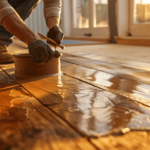People spent a lot more time at home in the last year or so, which gave them a lot of time to think about whether or not they liked their homes. A lot of people decided they didn’t. That helps explain the sharp rise in home improvement projects.
Of course, much of this home remodeling fell into the domain of cosmetic, DIY work. For example, people finally repainted that guestroom. For others, though, it has or will culminate in more extensive renovations that require the help of pros.
If you’re in that group, keep reading a home renovation checklist that will help you prepare and avoid missing anything important along the way.
click here – What to Know When Building or Buying a New Home
Budget
Much like buying a home, you need a budget in place ahead of time to understand how much home renovation you can really afford. Some people start thinking about renovations in advance and save up for them.
Saving can get you there, but you need a very, very clear idea of what you want and what it will cost. This can prove tricky since material costs can and do change over time.
Other people get a home renovation loan, such as a renovation loan by Plenti, to finance the work. A home remodel loan can work well if you have a stable income and good credit.
It’s also a way for you to keep money that you’ve saved up for renovations in reserve. If all goes well, you can use those cash reserves to pay the loan without major changes in your lifestyle.
Set the Scope
Once you determine your budget, you’re in a much better position to set the scope of the project. While it’s by no means a foolproof method, you can look at average costs for similar projects.
For example, an average kitchen remodel runs a little under $26,000. A bathroom remodel typically runs about $11,000. A full home remodel averages around $50,000.
These averages can give a general idea of what your costs can look like for specific kinds of projects.
You should employ some caution when using these average costs, though. They often make assumptions that won’t necessarily apply to your home.
For example, they’ll often use a 2500-square-foot home as the basis for the average. They’ll also often assume you’re aiming for a mid-range remodeling in terms of appliances, fixtures, and materials. They also don’t necessarily reflect local pricing conditions.
Even so, they can help you understand if you’re expecting too much remodeling for the budget you have available.
staircases is also the best option that make your interior more attractive and mordern.
Planning
The scope of your project can play a very strong role in the planning phase of your renovations, such as whether you want an interior designer, an architect, or both.
A general rule of thumb is that you need an architect if you plan on making structural changes. Structural changes in your home involved engineering concerns, such as load-bearing walls. Architects possess the engineering background to ensure that your new floor plans are also safe floor plans.
You may even want an architect on projects like a kitchen remodel if you foresee changes in your plumbing or wiring. For example, you may need new pipes and outlets if you want things arranged differently in the kitchen. There are electrical and plumping codes that the architect can help you address.
If you don’t plan on major structural changes, you may only need an interior designer. The interior designer helps you plan the overall look and feel of the space.
click here – How to achieve the goal of formal education system?
Bidding and Picking a Contractor
Unless you already picked out the contractor you want, you’ll ask for bids on the projects for a handful of contractors. You should do some research in advance before asking for bids. Some architects will offer recommendations or even handle the bidding and picking of a contractor.
Check out the contractors’ websites and look at previous projects. See how long the contractors have been in business. Look for reviews of their services online. Ask around for recommendations.
All of that can help you narrow the field to a manageable list. You should expect the contractors to come out to the house and make a pretty thorough inspection. They need a close look at the place to make an accurate bid.
Once you get the bids, you should look them over carefully. Most of the bids should resemble each other fairly closely.
Watch out for bids that run much lower or substantially higher. Low bids, in particular, are often a red flag that the contractor will either cut corners or doesn’t understand the full scope of the job.
Permits and Permissions
Major renovations typically require permits from your local town or city government. For example, let’s say your renovations include outside work to boost curb appeal, such as putting in a new fence. That fence may require a permit.
Other things that typically require permits include:
- Additions
- Plumbing and electrical
- Windows
- Decks
The good news is that your contractor should know what permits you need and apply for them with the correct offices. Getting permits can take as much as a month or more in some places, so you must employ some patience.
If you belong to a homeowners association, you’ll probably need approval from them for any major changes to the exterior of your home. You should talk with them during the planning phase to feel them out about your ideas. That will smooth the way when you get into the approval phase.
Construction
So, after all the planning, getting permits, and securing approvals, it’s time for the construction to start. Unless your project is a very small project or confined to an area of the home you don’t use very often, there is a good chance you’ll need somewhere else to live for a while. For whole home renovations, it’s almost always a necessity.
There is too much disruption going on for most people to maintain quality of life during the work. After all, the electricity or running water might go off for days at a time.
As part of the bid process, your contractor will typically include a fairly detailed breakdown of the project timeline. So, you will have a general idea of what work will happen when. Most contractors will also update you periodically on the project as they go.
Inspectors will also visit your home periodically during the construction law phase to ensure the new work meets all local regulations and national code requirements.
Some homeowners like to physically visit the house while the work goes on, while others prefer a reveal once the work is complete. While your contractor will accommodate your visits, it’s a good idea to let them know you’re coming. That way, they can make sure they aren’t preoccupied while you’re there.
Expect Delays
Delays are one of the most frustrating parts of home renovations for a homeowner. You can spare yourself a lot of mental anguish if you go into the process expecting that delays will happen.
If your contractor finishes right on schedule, it’s a pleasant surprise. If there are delays, it won’t come as a huge aggravation or surprise. Delays can come in a lot of forms, so let’s break down some of the more common ones.
Weather
Probably the single most common delay in any renovation project is the weather. Weather prediction has come a long way in the last few decades, but it’s not that good.
You likely scheduled your renovations months in advance. The best home remodeling contractor in the world can’t know for sure that you’ll see two straight weeks of rain when they planned on putting up siding, changing your landscaping, or replacing the roof. They can theoretically keep working inside, but that outside work will get pushed down the road.
Unforeseen Problems
It’s not as likely as bad weather, but contractors routinely find unforeseen problems in older homes. They may discover that some of your wiring is dangerously old and out of code. They might discover a mold problem in your walls.
Resolving these problems takes time that no one planned on. At the very least, your contractor must find someone who can fix the problem and do so in the immediate future. Until that problem gets resolved, the work on your home may slow or grind to a complete halt
Material Availability
Ever since the Covid pandemic disrupted life as everyone knew it, contractors have faced problems with material availability. They can take some actions to limit the problem, such as ordering well in advance of the planned start date. Still, it’s not a completely avoidable problem.
Using the Home Renovation Checklist
The home renovation checklist above helps you navigate the renovation process by addressing the major phases of all renovation projects. It also addresses those phases in the most common order that they happen.
By proceeding through the checklist in order, you can often avoid unnecessary delays. It also helps ensure that you plan a project you can reasonably afford.
Looking for more insights about or ideas for renovating your home. Check out the posts over in our Home Improvement section.





